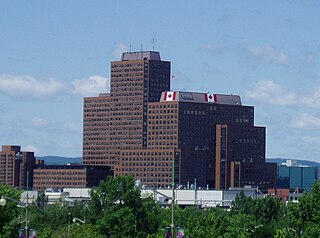Related Research Articles
Present-day telecommunications in Canada include telephone, radio, television, and internet usage. In the past, telecommunications included telegraphy available through Canadian Pacific and Canadian National.

The Canadian Radio-television and Telecommunications Commission is a public organization in Canada with mandate as a regulatory agency for broadcasting and telecommunications. It was created in 1976 when it took over responsibility for regulating telecommunication carriers. Prior to 1976, it was known as the Canadian Radio and Television Commission, which was established in 1968 by the Parliament of Canada to replace the Board of Broadcast Governors. Its headquarters is located in the Central Building of Les Terrasses de la Chaudière in Gatineau, Quebec.
Telecommunications in Dominica comprises telephone, radio, television and internet services. The primary regulatory authority is the National Telecommunication Regulatory Commission which regulates all related industries to comply with The Telecommunications Act 8 of 2000.
Telecommunications in France are highly developed. France is served by an extensive system of automatic telephone exchanges connected by modern networks of fiber-optic cable, coaxial cable, microwave radio relay, and a domestic satellite system; cellular telephone service is widely available, expanding rapidly, and includes roaming service to foreign countries.
Telecommunications in Gabon include radio, television, fixed and mobile telephones, and the Internet.
The telecommunications and postal services market in Greece is regulated by the Hellenic Telecommunications and Post Commission (EETT).
The Isle of Man has an extensive communications infrastructure consisting of telephone cables, submarine cables, and an array of television and mobile phone transmitters and towers.
The services of communication in Jersey comprise Internet, telephone, broadcasting and postal services, which allow islanders to contact people and receive information from outwith the island.
Telecommunications had an early beginning in Mauritius, with the first telephone line installed in 1883, seven years after the invention of the telephone. Over the years, the network and telephony improved. By the late 20th century, the rapid development and convergence of information and telecommunications technologies gave rise to an ICT industry on the island along with many incentives provided by the government. The government thus aims to make the ICT sector the 5th pillar of the Mauritian economy and Mauritius a Cyber Island. Historically, the country is known for tourism, rather than its call centers and business process outsourcing.
Monaco Telecom is the main telecommunications provider in the Principality of Monaco.
Telecommunications in Namibia include radio, television, fixed and mobile telephones, and the Internet.
The People's Republic of China possesses a diversified communications system that links all parts of the country by Internet, telephone, telegraph, radio, and television. The country is served by an extensive system of automatic telephone exchanges connected by modern networks of fiber-optic cable, coaxial cable, microwave radio relay, and a domestic satellite system; cellular telephone service is widely available, expanding rapidly, and includes roaming service to foreign countries. Fiber to the x infrastructure has been expanded rapidly in recent years.
In South Korea, telecommunications services improved dramatically in the 1980s with the assistance of foreign partners and as a result of the development of the electronics industry. The number of telephones in use in 1987 reached 9.2 million, a considerable increase from 1980, when there were 2.8 million subscribers.

Saint Pierre and Miquelon, officially the Territorial Collectivity of Saint-Pierre and Miquelon, is a self-governing territorial overseas collectivity of France in the northwestern Atlantic Ocean near the Canadian province of Newfoundland and Labrador. Saint Pierre and Miquelon is the remaining vestige of the once vast territory of New France. Its residents are French citizens; the collectivity elects its own deputy to the National Assembly and participates in senatorial and presidential elections. It covers 242 km2 (93 sq mi) of land and shores and had a population of 6,008 as of the March 2016 census.
Modern telecommunications in Thailand began in 1875 with the deployment of the first telegraph service. Historically, the development of telecommunication networks in Thailand were in the hands of the public sector. Government organisations were established to provide telegraph, telephone, radio, and television services, and other government agencies, especially the military, still control a large estate of radio and television spectra. Private telecommunication operators initially acquired concession agreements with state enterprises. For mobile phone services, all the concessions have been amended by successive government to last 25 years have gradually ended in 2015. For other services, the concession terms and conditions vary, ranging from one to fifteen years. Nearly all of the concessions are build-operate-transfer (BTO) contracts. The private investor has to build all the required facilities and transfer them to the state before they can operate or offer services to public.
Telecommunications in Albania include radio, television, fixed and mobile telephones, and the Internet.
CBAFT-DT, virtual and VHF digital channel 11, is an Ici Radio-Canada Télé owned-and-operated station licensed to Moncton, New Brunswick, Canada, serving Acadians in the Maritimes and Franco-Newfoundlanders in Newfoundland and Labrador. Owned by the Canadian Broadcasting Corporation, it is part of a twinstick with Fredericton-based CBC Television station CBAT-DT. CBAFT-DT's studios are located at 165 Main Street in Moncton, adjacent to the Dieppe border and the CF Champlain shopping centre, and its transmitter is located on Timberline Road in Moncton.

Canal D is a Canadian French language discretionary service owned by Bell Media. Canal D focuses on documentary programming primarily in the form of documentary-style television series that focus on a variety of topics such as crime, biographies, nature, and science.
Telecommunications in Djibouti falls under the authority of the Ministry of Communication & Culture.
Telecommunications in Taiwan comprise the following communication media, deployed in the Taiwan Area of the Republic of China and regulated by the National Communications Commission of the Executive Yuan.

